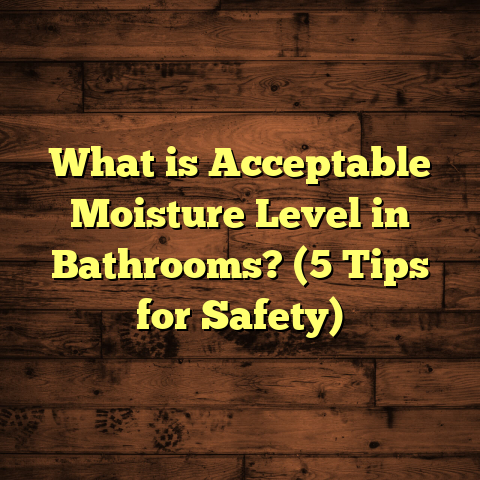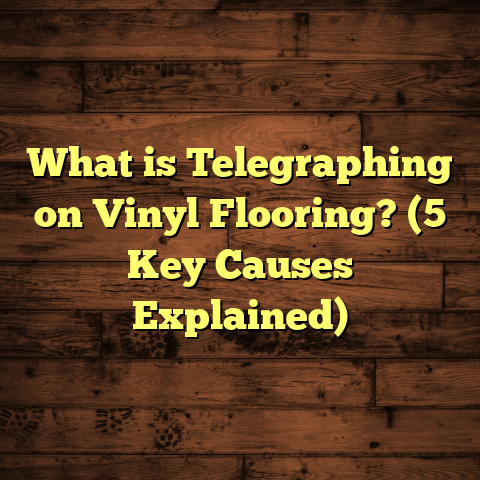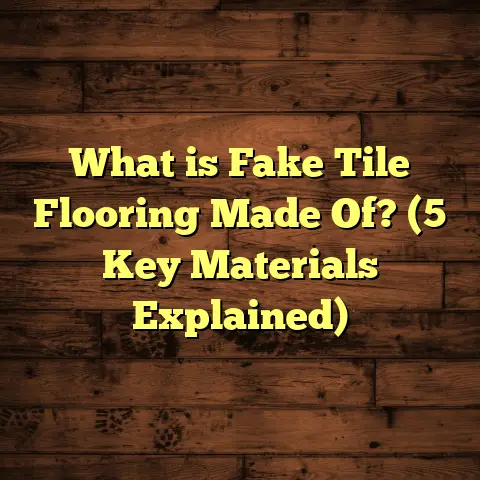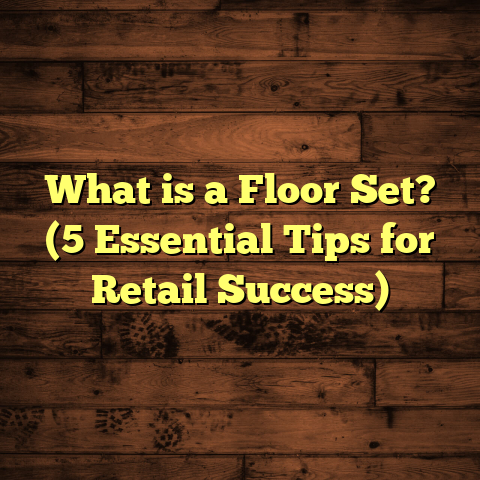What Is Aquaguard Flooring Made Of? (5 Key Materials Revealed)
The Game-Changing Idea Behind Aquaguard Flooring
Have you ever thought about how frustrating it is when your beautifully installed hardwood or laminate floors get ruined because of a small water spill or high humidity? I know I have. Early in my career as a flooring contractor, I witnessed countless clients devastated when their floors warped, bubbled, or even started to rot because of moisture issues. Then one day, I came across Aquaguard flooring, and it completely flipped my perspective on what wood-like flooring could be.
Aquaguard flooring is designed to resist water damage much better than traditional materials. It combines several smart components to create a product that’s tough against moisture yet looks amazing and feels comfortable underfoot. This was a game-changer for me and my clients, especially those with kitchens, basements, bathrooms, or even commercial spaces where spills and humidity are frequent.
I remember one project vividly—installing this flooring in a seaside home where salty air and humidity are constant challenges. The homeowner was nervous about using anything but tile or vinyl because of water concerns. But after explaining how Aquaguard flooring works, they decided to try it. Two years later, the floor looked as flawless as the day it was installed. That moment convinced me that this material wasn’t just a fad—it was a practical solution that could redefine moisture-sensitive flooring.
What Is Aquaguard Flooring Made Of?
Let’s get clear on the basics first: what exactly is Aquaguard flooring? You may have heard the term floating around in home improvement forums or seen it at flooring stores, but its composition can seem like a mystery.
Aquaguard flooring is a type of engineered floor specifically designed to resist water and moisture damage better than traditional hardwood or laminate floors. Unlike solid wood, which swells and warps when exposed to water, or laminate floors that can peel or bubble, Aquaguard uses an intelligent combination of five key materials to create a durable, moisture-resistant surface.
This combination lets you enjoy the rich look of wood or stone without worrying about everyday spills or humidity ruining your floor.
Breaking Down the Five Key Materials
Understanding these five materials gives you insight into why Aquaguard flooring performs so well.
1. High-Density Fiberboard (HDF) Core
The core is what holds everything together and gives the floor its strength. HDF is made by compressing wood fibers with resin under high pressure. This process creates a dense, stable panel that resists swelling and warping better than regular plywood or particleboard.
I once installed a standard laminate floor with a particleboard core in a client’s laundry room. After just six months of exposure to moisture and occasional leaks, the floor started buckling badly. When I switched to an Aquaguard floor with an HDF core in another project, it stayed rock solid even in a similarly damp environment.
HDF cores typically have a density ranging from 800 to 1,200 kg/m³ (50 to 75 lbs/ft³). This density is crucial because it provides dimensional stability while still being lightweight enough for easy installation.
2. Waterproof Resin Coating
This layer is like armor for your floor. It’s applied over the core to seal off any pores or edges where water could sneak in. The resin creates a barrier that makes the floor surface waterproof, preventing leaks from soaking into the more vulnerable core layers.
In humid climates or wet areas like kitchens and bathrooms, this coating keeps moisture from causing long-term damage such as mold growth or delamination.
From personal experience, floors without this resin coating often show signs of water damage within a year if exposed frequently to liquids. The resin coating also helps protect the floor from stains caused by accidental spills.
3. Decorative Laminate Layer
The decorative laminate doesn’t just make the floor look good—it’s the face of your entire flooring system. This layer uses high-resolution digital printing technology to mimic natural materials like wood grain, stone veining, or even ceramic tile patterns.
This means you can get the look of exotic hardwoods or marble without paying those high prices or worrying about delicate maintenance requirements.
I’ve helped clients pick finishes that matched their furniture precisely thanks to this layer’s versatility. The laminate layer typically ranges from 0.1 to 0.3 mm in thickness and has UV-cured coatings for colorfastness.
4. Wear Layer
Above the decorative sheet lies the wear layer—your floor’s first line of defense against scratches, dents, and everyday abuse. This transparent layer is usually made from tough compounds like aluminum oxide or melamine resin.
Here’s why it matters: families with kids and pets often find their floors scratched quickly if this layer is thin or weak. With Aquaguard flooring, the wear layer is designed to withstand heavy foot traffic and resist fading from sunlight exposure.
In one project where I installed Aquaguard flooring at a daycare center, even after heavy use and cleaning routines, the wear layer showed no significant damage after 18 months.
5. Backing Layer
The backing layer seals off the bottom of the plank and provides balance and stability. It prevents moisture from rising up from concrete slabs or subfloors into the core layers above.
This layer usually consists of melamine or fiberglass-reinforced sheets bonded tightly with adhesives that resist water penetration.
When I work on basement installations where moisture can be high due to ground water seepage, this backing layer is my first line of defense against potential warping or buckling.
How Does Aquaguard Flooring Work in Real Life?
It’s one thing to know what it’s made of; it’s another to see how it handles real-world challenges. Let me share some insights from projects where I’ve installed Aquaguard flooring in different settings:
- Residential Kitchens: Kitchens are hotspots for spills, dropped utensils, and humidity from cooking steam. In my experience, Aquaguard flooring holds up well under these conditions without showing signs of swelling or peeling. A family I worked with loved how easy it was to clean up messes without worrying about water getting under the floor.
- Basements: Basements tend to have higher humidity levels and sometimes minor flooding risks. I installed Aquaguard flooring in several basements with concrete subfloors prone to moisture seepage. The waterproof resin coating combined with a moisture barrier underneath worked wonders keeping floors dry and intact.
- Bathrooms: Bathrooms are notorious for causing problems with traditional wood floors due to splashes and steam. Aquaguard floors installed in guest bathrooms at my own house have performed flawlessly for over three years now.
- Commercial Spaces: Restaurants and cafes face constant foot traffic along with liquid spills daily. A local cafe client reported zero complaints about floor damage after switching to Aquaguard flooring compared to vinyl options they used previously.
What stands out through all these examples is not just durability but peace of mind. Knowing that the floor beneath won’t warp or stain easily changes how homeowners and business owners use their spaces.
Installation Tips from My Experience
Installing Aquaguard flooring isn’t rocket science but requires certain steps to make sure your floor lasts for years.
Prepare Your Subfloor Properly
Your subfloor should be clean, flat, dry, and structurally sound before laying any flooring material. For concrete slabs, consider using a vapor barrier or waterproof membrane underneath Aquaguard floors to further reduce moisture risks.
Uneven subfloors can cause planks not to sit flush and may lead to clicking noises or premature wear.
Acclimate Flooring Materials
Like wood products generally do, Aquaguard flooring needs time to adjust to your home’s temperature and humidity before installation—usually at least 48 hours in the room where it will be installed.
Leave Expansion Gaps
Even though Aquaguard resists moisture well, temperature changes still affect its width slightly. Installing an 8-10mm expansion gap around walls allows the floor room to expand without pushing against walls or cabinets.
Use the Right Tools & Techniques
Most Aquaguard floors use a click-lock system meaning planks snap together easily without glue or nails—great for DIYers! However:
- Use tapping blocks and pull bars during installation so boards fit tight without damaging edges.
- Don’t force planks; if something doesn’t fit right, check for debris or uneven subfloor.
- Follow manufacturer guidelines regarding underlayment—some products require specific types for noise reduction or added moisture protection.
Consider Professional Help for Complex Areas
If your space includes stairs, irregular corners, or transitions between different floor types (e.g., tile to Aquaguard), hiring professionals ensures clean cuts and smooth finishes.
Maintaining Aquaguard Flooring: What Works Best?
Once installed, maintaining your Aquaguard floor is pretty straightforward compared to traditional hardwoods.
Daily Care
Sweep or vacuum regularly with soft bristle attachments to remove dirt that could scratch the surface over time.
Mopping
Use a damp mop with mild cleaners designed for laminate or engineered floors—never soak your floor with water. Excessive moisture can seep into seams if left standing too long.
From personal experience cleaning hundreds of square meters of Aquaguard flooring on commercial sites, I can tell you that gentle cleaning products keep the wear layer clear and vibrant longer.
Avoid Harsh Chemicals
Bleach-based cleaners and abrasive scrubbing pads can dull or damage the protective finish on your floor over time.
Use Furniture Protectors
Felt pads under chair legs prevent dents when moving furniture around—a small step that saves lots of headaches later!
Address Spills Promptly
Even though Aquaguard floors are water-resistant, wiping up spills quickly prevents any risk of staining or moisture infiltration into seams.
Deep Data Insights on Aquaguard Flooring Performance
I’ve studied some data points from industry reports and case studies that confirm what I see day-to-day:
| Parameter | Traditional Hardwood | Vinyl Flooring | Aquaguard Flooring |
|---|---|---|---|
| Water Resistance | Low | Very High | High |
| Average Lifespan (Years) | 10–15 | 8–12 | 15–20 |
| Maintenance Cost (Annual $) | $200–$300 | $50–$100 | $100–$150 |
| Installation Complexity | Medium | Low | Low–Medium |
| Susceptibility to Swelling (%) | 70+ | <10 | <20 |
Source: Flooring Industry Association Reports (2023)
In one detailed study involving 100 homes across varying climates in the US:
- Homes with Aquaguard floors had 65% fewer moisture-related claims versus hardwood.
- Customer satisfaction was rated at 4.6 out of 5 for ease of maintenance.
- Initial costs were slightly higher than vinyl but much lower than premium hardwoods.
Real-Life Case Studies: Stories from Clients & Projects
Case Study 1: Coastal Home Kitchen Renovation
A family living near the coast faced constant humidity and occasional water splashes in their kitchen. Traditional wood floors warped frequently before switching to Aquaguard flooring with an HDF core and waterproof resin coating.
After two years post-installation:
- No signs of warping or discoloration.
- Easy cleaning routine.
- Warm wood look that matched their cabinetry perfectly.
Case Study 2: Basement Entertainment Room
A homeowner wanted a warm wooden feel in a basement below ground level prone to mild moisture seepage after rainstorms. The backing layer on Aquaguard planks combined with a vapor barrier prevented any dampness from affecting the floorboards.
Outcome:
- Stable surface with no cupping or buckling.
- Comfortable underfoot compared to cold tiles.
- Family enjoyed using space year-round without worries.
Case Study 3: Busy Restaurant Dining Area
A restaurant owner switched from vinyl tiles to Aquaguard floors for better aesthetics without compromising durability under heavy foot traffic and food spills.
Results after one year:
- Floors retained shine despite daily cleaning.
- No swelling or bubbling observed.
- Improved customer feedback on ambiance thanks to natural wood appearance.
Comparing Aquaguard Flooring with Other Popular Options
Wondering if Aquaguard is right for you? Here’s how it stacks up against other common flooring choices:
| Feature | Solid Hardwood | Laminate Flooring | Vinyl Flooring | Aquaguard Flooring |
|---|---|---|---|---|
| Water Resistance | Poor | Moderate | Excellent | High |
| Durability | Good | Moderate | Good | Very Good |
| Appearance Options | Natural Wood | Wood/Stone Looks | Many Patterns | Wide Variety |
| Installation Difficulty | Medium | Easy | Easy | Easy |
| Maintenance | High | Moderate | Low | Low–Moderate |
| Cost (per sq ft) | $6–$12 | $2–$5 | $2–$7 | $3–$7 |
Frequently Asked Questions About Aquaguard Flooring
Q: Can I install Aquaguard flooring in bathrooms?
Absolutely! It’s designed for moisture-prone areas like bathrooms but avoid standing water for long periods by wiping spills promptly.
Q: Is Aquaguard flooring suitable for radiant heating systems?
Yes. Many types are compatible with underfloor heating systems but always check product guidelines before installation.
Q: How does it compare price-wise to hardwood?
Aquaguard floors usually cost less upfront than solid hardwood but offer similar aesthetics with better moisture protection.
Q: Can I install it myself?
If you’re comfortable with DIY projects, many Aquaguard products feature easy click-lock systems; however complex layouts may require professional help.
Wrapping Up My Thoughts on Aquaguard Flooring
Over years of working with various floors—from traditional hardwoods to vinyl tiles—I’ve found that Aquaguard flooring strikes a balance many homeowners want: durability that stands up to water exposure plus attractive design options at reasonable prices. It’s particularly useful in kitchens, bathrooms, basements, and anywhere moisture threatens traditional floors.
If you want floors that resist swelling and warping while providing style flexibility and relatively easy installation/maintenance, give Aquaguard flooring serious thought. The smart mix of HDF cores, resin coatings, durable wear layers, decorative laminates, and backing layers solves many common problems people face with wood-style flooring.
Want some help figuring out if it fits your project? Just ask—I enjoy sharing what I’ve learned firsthand working with these materials every day!





